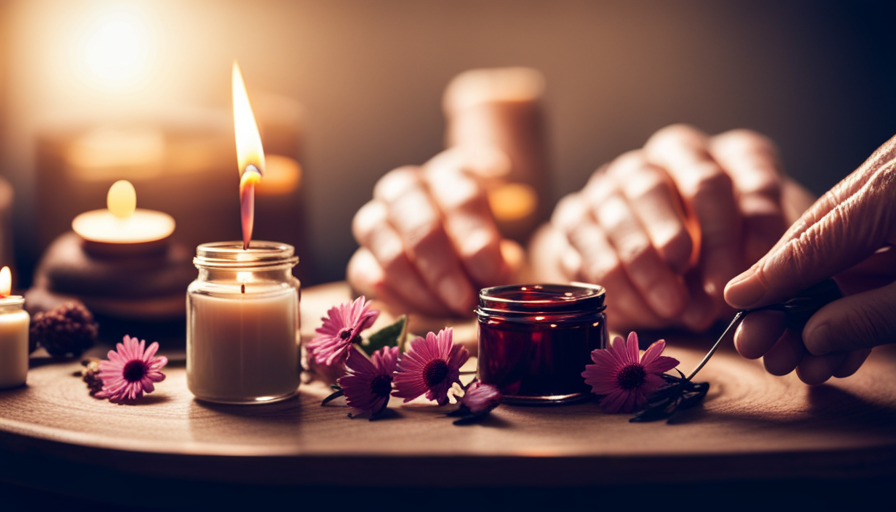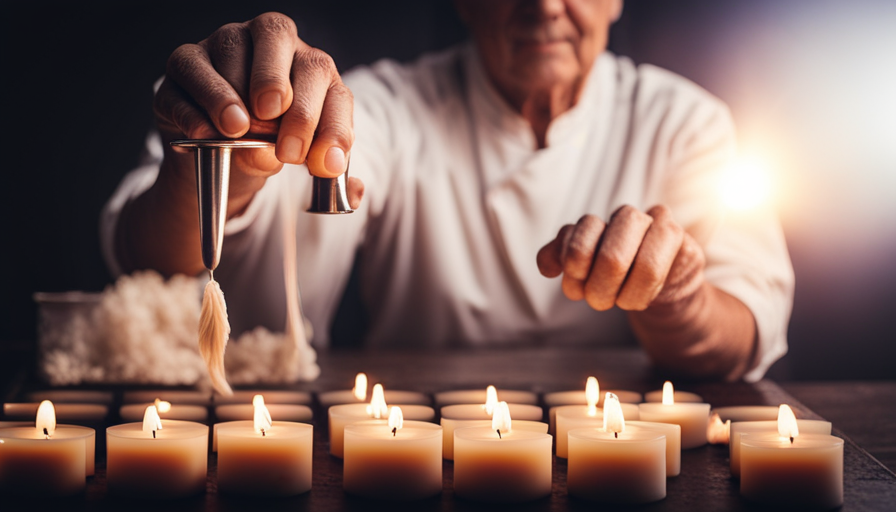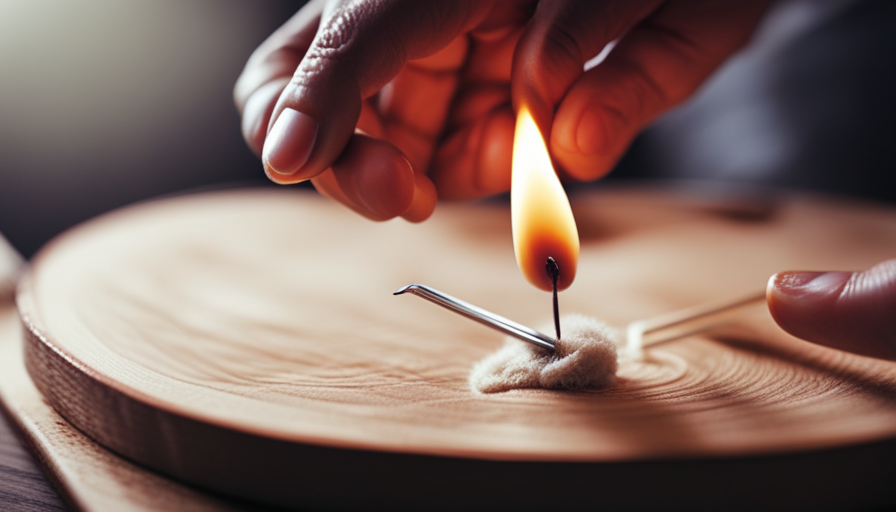Picture a serene getaway where the soft flicker of candles illuminates your skin, while the warm, aromatic wax wraps you in a tempting hug.
Creating your own massage candle is like capturing this tranquil escape in a jar. As a candle enthusiast and self-care advocate, I have perfected the art of crafting these luxurious treats for the body and soul.
In this article, I will guide you through the step-by-step process of making your very own massage candle, providing you with the tools and knowledge needed to create a truly indulgent experience. From selecting the perfect fragrance to testing the optimal temperature, I will share my expertise to ensure your candle delivers the ultimate relaxation and therapeutic benefits.
So, let’s dive into the world of massage candles and ignite your senses on a journey of pure bliss.
Key Takeaways
- Melting soy wax flakes in a heat-resistant container is the first step in making a massage candle.
- Essential oils can be added to the melted wax to enhance the therapeutic benefits of the candle.
- The wax should be heated to a temperature of 120 to 140 degrees Fahrenheit using a double boiler to prevent overheating.
- Slow pouring of the wax ensures even distribution and allows the fragrance oils to mix seamlessly with the wax.
Gather Your Supplies
Now that you’ve got everything you need, it’s time to gather your supplies like a bee collecting nectar from flowers. To make a massage candle, you’ll need the following supplies: soy wax flakes, a heat-resistant container, a wick, essential oils, a thermometer, and a double boiler.
The first step in the candle making process is to melt the wax. Place the soy wax flakes in the heat-resistant container and set it in a double boiler filled with water. Heat the water over medium heat until the wax melts completely.
While the wax is melting, prepare the wick by attaching it to the bottom of the container. You can use a small amount of melted wax to secure the wick in place.
Once the wax has melted, remove it from the heat and let it cool slightly. This is the perfect time to add your chosen essential oils. Be sure to use oils that are safe for skin contact and that blend well together. Stir the oils into the melted wax until they’re well incorporated.
With your supplies gathered and the wax melted, you’re now ready to move on to the next step in creating your massage candle, which is pouring the wax into the container.
Melt the Wax
First, you’ll need to begin by melting the wax until it transforms into a smooth, velvety liquid. This step is crucial in creating the perfect massage candle. To ensure the wax is at the right temperature, use a thermometer to test it. The ideal temperature for massage candles is around 120 to 140 degrees Fahrenheit. This ensures that the wax won’t burn the skin when applied during a massage.
When melting the wax, it’s important to use a double boiler to prevent direct heat contact and minimize the risk of overheating. Place the wax in the top pot of the double boiler and fill the bottom pot with water. Heat the water to a gentle simmer and allow the wax to melt slowly. This method provides a consistent and controlled heat source.
One of the benefits of using massage candles is that they can provide a warm and soothing ambiance to enhance relaxation. The melted wax can be poured directly onto the skin, providing a luxurious and moisturizing massage experience. The combination of heat and nourishing oils can help relieve muscle tension and promote blood circulation.
Now that the wax has melted to the perfect temperature and consistency, it’s time to move on to the next step: adding fragrance and essential oils. By infusing the wax with delightful scents, you can further enhance the therapeutic benefits of the massage candle.
Add Fragrance and Essential Oils
After melting the wax to the perfect temperature and consistency, it’s time to enhance the therapeutic benefits of your massage candle by infusing it with delightful scents and essential oils. Studies have shown that these oils can provide additional relaxation and stress-relief benefits.
When it comes to fragrance options, the possibilities are endless. You can choose from a wide range of essential oils, such as lavender for its calming properties, eucalyptus for its invigorating effect, or chamomile for its soothing aroma. Experimenting with different combinations can be fun and allows you to create a unique scent that suits your preferences.
Blending techniques play a crucial role in creating the perfect fragrance for your massage candle. One technique is to blend different essential oils together, creating a harmonious and balanced scent. Start by combining a base note oil, like vanilla or sandalwood, with a middle note oil, such as rose or jasmine, and finish with a top note oil like bergamot or lemon. This layering technique ensures that the scent evolves as the candle burns, providing a more enjoyable experience.
Now that the fragrance and essential oils have been carefully selected and blended, it’s time to pour the wax into the container.
Pour the Wax into the Container
When pouring the wax into the container, it’s important to secure the wick in place to ensure it stays centered and upright. This can be done by using a wick sticker or a small amount of melted wax to adhere the wick to the bottom of the container. Once the wick is secure, slowly pour the melted wax into the container, taking care to avoid any spills or splatters. By following these steps, you can ensure a successful and professional-looking massage candle.
Secure the Wick
To ensure a stable flame, it’s crucial to securely fasten the wick in place for your massage candle. Proper wick placement is essential for both the functionality and safety of your candle.
Begin by centering the wick in the middle of the container, ensuring it’s straight and upright. You can use a wick sticker or a small amount of melted wax to secure the wick at the bottom of the container. Gently press the wick into the wax to hold it firmly in place. This’ll prevent the wick from moving or falling over while the candle burns.
Once the wick is securely fastened, you can move on to the next step of slowly pouring the wax into the container, creating a soothing and aromatic massage candle.
Slowly Pour the Wax
As you carefully pour the wax, a river of warmth and fragrance flows into the container, transforming it into a tranquil haven. Slowly pouring the wax is crucial in creating a massage candle that not only looks beautiful but also provides a luxurious experience.
By pouring the wax slowly, you allow it to evenly distribute and adhere to the container, preventing any air bubbles or uneven surfaces. This ensures a smooth and flawless appearance once the candle solidifies. Additionally, slow pouring allows the fragrance oils to mix seamlessly with the wax, creating a harmonious blend that fills the room with a captivating aroma.
The benefits of slow pouring extend beyond aesthetics and scent. It also helps to prevent any potential overheating of the container, which could lead to cracks or breakage. So, take your time and pour the wax slowly, savoring each moment of the process.
Now, let the candle cool and set, allowing the magic to happen.
Let the Candle Cool and Set
Once the candle has finished melting, you can sit back and watch as it slowly cools and solidifies into a beautifully scented massage candle.
The cooling process is a crucial step in candle making as it allows the wax to harden and set properly. Patience is key during this stage, as rushing the cooling process can result in uneven texture or cracking of the candle.
During the cooling process, it’s important to resist the temptation to touch or move the candle. Any disturbance to the wax can cause imperfections in the final product. Instead, find a safe and undisturbed spot for the candle to cool, away from drafts and direct sunlight.
As the candle cools, you may notice a slight color change and a thin film forming on the surface. This is completely normal and indicates that the wax is solidifying.
Allow the candle to cool completely, which usually takes a couple of hours, before continuing to the next step.
Once the candle is fully cooled and set, it’s time to trim the wick. Trimming the wick ensures a clean and even burn, allowing the candle to last longer.
Trim the Wick
After the candle has cooled and set, it’s time to give the wick a little trim for a cleaner and longer-lasting burn. Proper wick trimming techniques are essential to ensure that your massage candle performs optimally. By trimming the wick, you remove any excess charred bits, allowing the flame to burn evenly and reducing the risk of soot and smoke.
To trim the wick, you’ll need the best wick trimmers available. Look for trimmers specifically designed for candles, as they have a unique shape that allows for precision trimming. These trimmers typically have a long handle and a curved blade, making it easy to reach the wick without disturbing the surrounding wax.
When trimming the wick, make sure to leave about 1/4 inch of wick above the wax surface. This length is ideal for a controlled and steady burn. Trim any longer wicks to prevent the flame from becoming too large and potentially causing the wax to overheat.
Now that the wick is trimmed, you’re ready to light and enjoy your massage candle. The carefully trimmed wick will ensure a clean and efficient burn, providing you with hours of relaxation and ambiance.
Light and Enjoy
Before enjoying the massage candle, it’s important to find a relaxing environment where you can fully immerse yourself in the experience. This could be a quiet room with soft lighting and comfortable furniture.
Once you’ve created the perfect ambiance, it’s time to light the candle and let the soothing fragrance fill the air. Take a moment to breathe in the calming scent and allow yourself to unwind as the candle begins to melt, releasing the warm, nourishing oils.
Find a Relaxing Environment
To create a truly serene atmosphere for your massage candle experience, immerse yourself in a tranquil environment that is free from distractions. Creating a peaceful ambiance is crucial to enhance relaxation and promote a sense of calm. Start by choosing a room that is quiet and comfortable, ensuring the temperature is just right. Dim the lights or use candles to create a soft, soothing glow. Selecting the right music is another essential element in setting the mood. Opt for gentle melodies or nature sounds that will help you unwind and destress. To assist you further, here is a table with three suggestions for creating a relaxing environment:
| Element | Description |
|---|---|
| Lighting | Soft, warm lighting to create a cozy atmosphere |
| Scent | Aromatherapy scents like lavender or chamomile for relaxation |
| Comfortable Seating | Plush cushions or a comfortable massage table for ultimate comfort |
Now, let’s transition into the next section and learn how to light the candle for your massage experience.
Light the Candle
Illuminate the room by igniting the wick of your scented wax, infusing the air with a gentle flicker and a soothing fragrance. When lighting the candle, it’s important to consider the lighting techniques that can enhance the benefits of candlelight therapy.
Soft, warm lighting creates a calming ambiance that promotes relaxation and reduces stress. The gentle glow of the candlelight can help to create a peaceful atmosphere, allowing you to unwind and fully immerse yourself in the massage experience.
Candlelight therapy has been known to have numerous benefits, including improved sleep quality, reduced anxiety, and enhanced mood. As the flickering flame dances, it creates a sense of tranquility, helping you to let go of any tension or worries.
Now that the candle is lit, let’s move on to the next step and melt the wax for massage.
Melt the Wax for Massage
Once the wax’s fully melted, carefully pour it into the candle jar. This step’s crucial in creating a perfect massage candle. To ensure a smooth and even pour, it’s important to melt the wax using proper techniques.
There are various wax melting techniques that can be employed, such as using a double boiler or a microwave. It’s essential to choose the method that suits your preferences and the type of wax you’re using.
When it comes to massage candles, there’re different types available in the market. Some’re made from soy wax, while others’re made from beeswax or a blend of various oils. Each type has its own unique properties and benefits, so it’s worth exploring the options and finding the one that best suits your needs.
To evoke a sense of excitement and anticipation in our audience, here’re some discussion ideas to consider:
- Discover the soothing properties of soy wax.
- Explore the alluring scent options available.
- Delve into the benefits of using beeswax in massage candles.
- Learn about the different techniques to personalize your massage candle.
Now that the wax’s been poured into the candle jar, the next step’s to test the temperature before using it for a massage.
Test the Temperature
After melting the wax for the massage candle, it’s important to test the temperature before pouring it into the container. This step ensures that the wax is at a safe and comfortable temperature for use on the skin. To test the temperature, I recommend using a thermometer specifically designed for candle making. Simply insert the thermometer into the melted wax and wait for it to stabilize. The ideal temperature for massage candles is between 110 to 130 degrees Fahrenheit (43 to 54 degrees Celsius). This range ensures that the wax is warm enough to provide a soothing and relaxing experience, but not too hot to cause discomfort or burns.
To emphasize the importance of temperature testing, I have created a table below:
| Temperature Range | Effect on the Skin |
|---|---|
| Below 110°F (43°C) | Wax will be too cool and may not provide desired warmth |
| 110°F – 130°F (43°C – 54°C) | Optimal temperature for a soothing and relaxing massage |
| Above 130°F (54°C) | Wax will be too hot and may cause burns |
By ensuring the wax is within the recommended temperature range, you can experience the full benefits of massage candles without any discomfort. In the next section, we will explore the various benefits you can expect from using massage candles.
Experience the Benefits
Indulge in the numerous advantages of incorporating massage candles into your self-care routine. Not only do these candles create a warm and soothing ambiance, but they also offer a host of benefits that enhance your overall well-being.
Massage therapy has been known to relieve stress, reduce muscle tension, and improve circulation. By using a massage candle, you can experience these benefits in the comfort of your own home.
One of the key benefits of massage therapy is its ability to promote relaxation. The gentle warmth from the candle, combined with the calming scent of essential oils, can help you unwind after a long and stressful day. Additionally, the act of massaging the melted oil onto your skin can release tension and tightness, leaving you feeling rejuvenated and refreshed.
Another advantage of massage candles is their versatility. Depending on your needs, you can choose from different types of massage techniques. For example, a Swedish massage candle is ideal for relieving muscle tension and promoting relaxation, while a deep tissue massage candle provides a more intense and targeted therapy for sore muscles.
Incorporating massage candles into your self-care routine can provide a multitude of benefits for both your body and mind. So why not treat yourself to a little indulgence and experience the wonders of massage therapy in the comfort of your own home?
Frequently Asked Questions
How do I choose the right fragrance and essential oils for my massage candle?
Choosing the right fragrance for your massage candle is crucial. The aroma should transport you to a world of relaxation and bliss. I recommend indulging in exotic scents like lavender, eucalyptus, or vanilla.
As for essential oils, they offer a multitude of benefits. Lavender promotes calmness, eucalyptus helps alleviate muscle tension, and vanilla creates a warm and soothing atmosphere.
These carefully selected fragrances and oils will enhance your massage experience and leave you feeling rejuvenated.
Can I use any type of container to pour the wax into?
Choosing the right container for your massage candle is crucial for creating a high-quality massage oil. The type of container you use can affect the overall quality of the oil and the experience for the person receiving the massage.
It’s important to choose a container that is heat-resistant, non-toxic, and preferably made of glass or metal. These materials ensure that the candle burns evenly and the oil is safe and free from any harmful chemicals.
How long does it take for the candle to cool and set?
The cooling and setting time of a massage candle can vary depending on various factors, such as the size of the candle and the type of wax used. Generally, it takes around 1-2 hours for the candle to cool and set completely.
During this time, it’s important to ensure that the candle is placed in a cool and undisturbed area to allow it to solidify properly. This will ensure that the candle is ready for use and will provide an optimal massage experience.
Is it necessary to trim the wick before lighting the candle?
Yes, it’s necessary to trim the wick before lighting the candle. Wick maintenance is an important aspect of candle safety. Trimming the wick to about 1/4 inch helps prevent the flame from becoming too large and causing the candle to burn unevenly or produce excessive smoke. By regularly trimming the wick, you can ensure a cleaner and safer burning experience while enjoying the soothing ambiance of your massage candle.
What are the benefits of using a massage candle?
Using a massage candle is like experiencing a warm embrace that melts away stress and tension. The benefits of using a massage candle are numerous.
Firstly, it provides a soothing and aromatic ambiance, creating a calming atmosphere for relaxation.
Secondly, the warm, melted wax can be applied directly to the skin, providing a luxurious and moisturizing massage experience.
To effectively use a massage candle for relaxation, simply light the candle, allow it to melt, and then pour the warm wax onto the desired area for a blissful and rejuvenating massage.
Conclusion
In conclusion, making your own massage candle can be a fun and rewarding experience. By following these simple steps, you can create a luxurious and relaxing atmosphere in your own home.
So go ahead and gather your supplies, melt the wax, add your favorite fragrance and essential oils, pour into a container, let it cool and set, and then light it up to enjoy the soothing benefits. Trust me, you’ll be feeling like a pampered queen in no time!
















